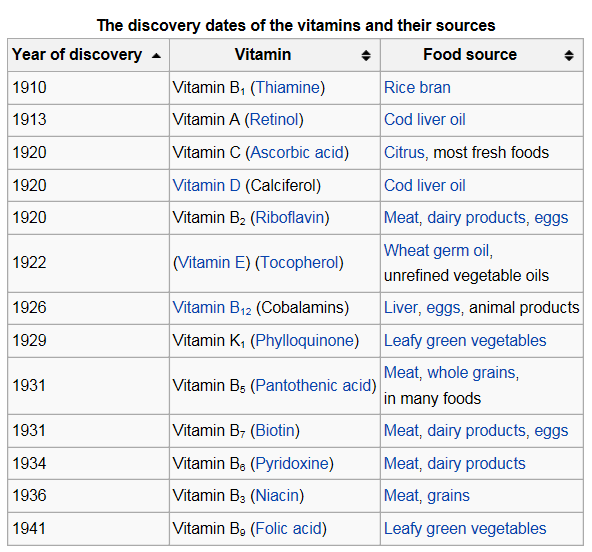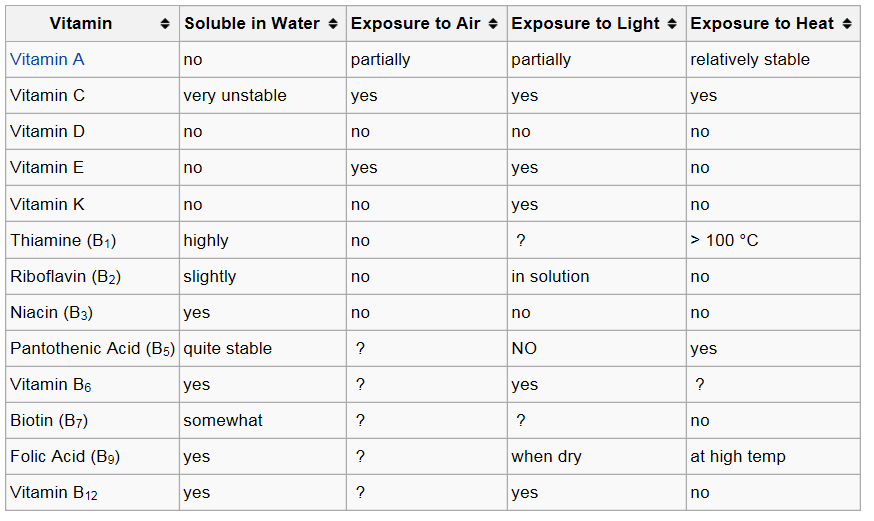VITAMINS
Vitamins are essential for the normal growth and development of a multicellular organism. Using the genetic blueprint inherited from its parents, a fetus begins to develop, at the moment of conception, from the nutrients it absorbs. It requires certain vitamins and minerals to be present at certain times. These nutrients facilitate the chemical reactions that produce among other things, skin, bone, and muscle. If there is serious deficiency in one or more of these nutrients, a child may develop a deficiency disease. Even minor deficiencies may cause permanent damage.
For the most part, vitamins are obtained with food, but a few are obtained by other means. For example, microorganisms in the intestine — commonly known as “gut flora” — produce vitamin K and biotin, while one form of vitamin D is synthesized in the skin with the help of the natural ultraviolet wavelength of sunlight. Humans can produce some vitamins from precursors they consume. Examples include vitamin A, produced from beta carotene, and niacin, from the amino acid tryptophan.
Once growth and development are completed, vitamins remain essential nutrients for the healthy maintenance of the cells, tissues, and organs that make up a multicellular organism; they also enable a multicellular life form to efficiently use chemical energy provided by food it eats, and to help process the proteins, carbohydrates, and fats required for respiration.
PRODUCTS LIST
Minimum Order 500kg
Vitamin C
Folic Acid
Beta Carotene
E No: E160e
Vitamin B1
Vitamin D3
Vitamin E
Vitamin K1
Vitamin K3 (Niacinamide)
D-Biotin
Inositol
Vitamin A
Nicotinic Acid
Vitamin B5
Vitamin E Oil
Ascorbyl Palmitate
Vitamin B6
Vitamin B2 (Riboflavin)
E No: E101
Vitamin A Acetate
Vitamin A Palmitate
Vitamine D2
A vitamin is an organic compound and a vital nutrient that an organism requires in limited amounts.
Vitamins have diverse biochemical functions. Some, such as vitamin D, have hormone-like functions as regulators of mineral metabolism, or regulators of cell and tissue growth and differentiation (such as some forms of vitamin A). Others function as antioxidants (e.g., vitamin E and sometimes vitamin C).The largest number of vitamins, the B complex vitamins, function as precursors for enzyme cofactors, that help enzymes in their work as catalysts in metabolism. In this role, vitamins may be tightly bound to enzymes as part of prosthetic groups: For example, biotin is part of enzymes involved in making fatty acids. They may also be less tightly bound to enzyme catalysts as coenzymes, detachable molecules that function to carry chemical groups or electrons between molecules. For example, folic acid may carry methyl, formyl, and methylene groups in the cell. Although these roles in assisting enzyme-substrate reactions are vitamins’ best-known function, the other vitamin functions are equally important.
Evidence for supplementation in those who are otherwise healthy do not show any benefit with respect to cancer or heart disease.
Vitamin A and E supplements not only provide no health benefits for generally healthy individuals, but they may increase mortality, though the two large studies that support this conclusion included smokers for whom it was already known that beta-carotene supplements can be harmful.
While other findings suggest that vitamin E toxicity is limited to only a specific form when taken in excess.
The European Union and other countries of Europe have regulations that define limits of vitamin (and mineral) dosages for their safe use as food supplements. Most vitamins that are sold as food supplements cannot exceed a maximum daily dosage. Vitamin products above these legal limits are not considered food supplements and must be registered as prescription or non-prescription (over-the-counter drugs) due to their potential side effects. As a result, most of the fat-soluble vitamins (such as the vitamins A, D, E, and K) that contain amounts above the daily allowance are drug products. The daily dosage of a vitamin supplement for example cannot exceed 300% of the recommended daily allowance, and for vitamin A, this limit is even lower (200%). Such regulations are applicable in most European countries.





